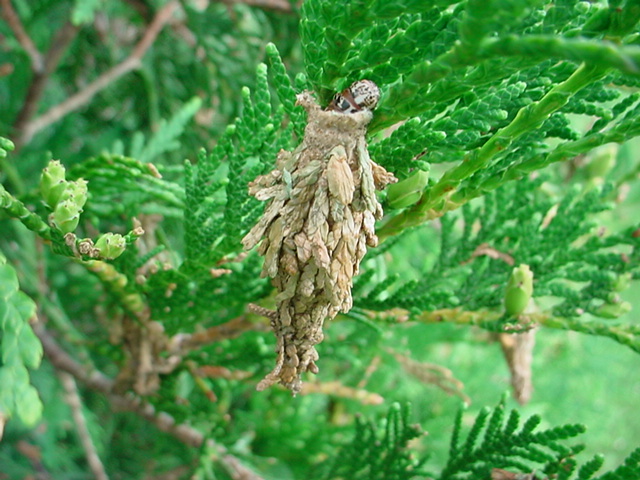Above and below: bagworm on arborvitae. Photo by John E. Woodmansee.
This is the time of year when people begin to notice dying evergreens. One notorious suspect for this condition is bagworms. They snuck into my evergreens at home without me noticing. I noticed a thin area in my spruce tree, and behold, bagworms! As Charlie Brown used to say, “Aaugh!”
Bagworm-infested trees or shrubs have probably been infested since early June. That is because they were small and because they used plant parts to disguise the silken bags they traveled around in. From a distance, they look somewhat like an upside-down pine cone hanging like a Christmas ornament.
Before we get to control options, we need to understand the life cycle of this pest.
Dr. Timothy Gibb, Purdue Extension entomologist, said, "During July and August, bagworms may defoliate arborvitae, junipers, and other trees and shrubs." He added, "Bagworms are caterpillars that live inside bags made of silken threads and plant material. They look like regular plant parts, so they are somewhat disguised from homeowners. The caterpillars crawl part way out of the bag to feed but retreat like a turtle into their shell if disturbed. The bag dangles like a Christmas ornament on a tree."

Many people confuse bagworms with fall webworms that form large cobwebs that are easily visible in deciduous trees. Bagworms are camouflaged better.
Gibb said bagworms mature in late August or early September. At this time the bags are about 2 inches long and the caterpillars can no longer be killed by pesticides. The caterpillars pupate and then turn into mature adults. The winged males leave their bags, mate with females, and then the females lay eggs inside the bag. The females never leave their bags. He says each female bag can produce over 1000 bagworms. The eggs overwinter in the bag, and then next spring young caterpillars hatch. They disburse and begin spinning their bag, and they start to feed.
Cliff Sadof, Purdue Extension entomologist, added that with such reproductive potential, one would wonder why there are any trees left at all. Fortunately, not all bagworm caterpillars survive. He said, "Many are killed by cold weather, birds, rodents, and small parasitic wasps."
Sadof said the first step to protect young trees and shrubs is to thoroughly examine them in early spring for the presence of overwintering bagworms. He said, "If you find less than 10 bags per plant, immediately pick them off and kill them by dropping them in a bucket of soapy water." If more than 10 are found, Sadof said you might want to spray an insecticide.
Sadof said bagworms can be controlled by spraying them in early- to mid-June with insecticides after eggs have hatched. Biorational insecticides, such as ones that contain Spinosad or Bt, can be used. Biorational insecticides kill caterpillars and avoid killing beneficial insects. Other insecticides labeled for the pest may also be used. Always follow label directions.
That's good advice for doing something in June, but what about now? I had a personal conversation with Dr. Sadof about this time of year not many years ago, and he said, "The question to be asking now is, 'Are they still feeding?' If they are not feeding, pesticides will have no effect on this pest." He said that is why in the late season, hand-picking is almost always the preferred method of control.
For more information, including possible insecticides to use if bagworm caterpillars are still actively feeding, find Purdue Extension publication E-27, "Bagworms," at www.edustore.purdue.edu.